A desperate air and sea rescue search continues for the five people on board the tourist submersible Titan that went missing near the wreck of the Titanic, as experts warn that the oxygen on the vessel is running out.
Scroll to the top for the latest updates.
Update, 10:08 p.m. ET: The Associated Press details the difficulties confronting rescuers who are trying to pinpoint the source of the noises that may be coming from the missing vessel:
“It’s not a simple problem,” said Matt Dzieciuch, an ocean acoustics expert at the Scripps Institution of Oceanography.
The ocean is a “noisy place,” Dzieciuch said. There are many other potential sources of sound under water, including from fish, other animals and of course human-made instruments, he explained.
The Coast Guard said search teams heard banging noises at 30-minute intervals.
But it’s still “speculative” whether the banging noises were a true signal of life, said Art Trembanis, a marine scientist at the University of Delaware. Even this kind of pattern could come from an underwater instrument making repeated noise.
Usually, an underwater vehicle will have a device called a pinger that can correspond with the surface and make it easier to locate, Dzieciuch said. But it’s unclear whether the Titan submersible was using one.
A big challenge is that the search team doesn’t know exactly what kind of signal they’re looking for, said Lora Van Uffelen, an ocean engineering researcher at the University of Rhode Island.
“They’re just kind of listening for anything,” she said.
Another challenge for the search team: Sound gets bent as it travels underwater, because of how pressure and temperature change at different depths, Dzieciuch said. This can create echo-like effects and make it hard to locate the source of a particular sound.
“Someone tapping, say, an S.O.S. at the bottom of the ocean might sound like just some random banging at the surface of the ocean,” he said. “It’s like shouting in a canyon. You can’t really understand what the person at the other end of the canyon is saying.”
The sounds in the Titan search were picked up using devices called sonobuoys, which can be tossed out of airplanes to detect noises to avoid interference with ship sounds, Dzieciuch said. These devices could help triangulate the location of the sub, but searchers would need to deploy many buoys to make it work, experts said.
But Van Uffelen said that despite the challenges, “sound is one of the best hopes they have of finding it.” Sound waves move farther underwater compared to on land, she said.
And in the underwater environment, sound also travels farther than light, she pointed out — so “it’s going to be easier to find it by listening than it would be by looking.”
Update, 8:40 p.m. ET: Mexican actor Alan Estrada shared disturbing details in a YouTube video about his own trip on the Titan during a July 2022 tour to the Titanic wreck, during which the sub’s batteries drained quickly and the trip was cut short, the UK Daily Mail reports.
“For safety reasons this is completely understandable when the last battery—the submersible has two batteries—when the second battery has only 40 percent left, it is necessary to return to the surface for safety,” Estrada said. “This means that the four hours that they tell you that you are going to be down there are not fulfilled.”
Estrada also said that Titan experienced communication difficulties during his trip when the sub lost contact with the surface for a period of time.
“After 1,000 meters Scott, the pilot, detects a failure in his communication system,” Estrada explained. “It is vital that we cannot communicate with the surface, otherwise we can get lost and drift in the middle of the ocean.”
After descending to about 21,000 feet, the sub pilot on Estrada’s expedition released the ballast tanks from each side of the vessel in order to floated back to the surface. They regained communication at some point along the way.
Update, 6:30 p.m. ET: In an eerie twist of fate, the wife of one of the Titan’s passengers is a descendant of two famous passengers who died on the Titanic, the New York Times reports.
Wendy Rush, the wife of OceanGate Expedition’s CEO Stockton Rush, who is on the missing submersible, is the great-great-granddaughter of Isidor and Ida Straus, two first-class passengers who were aboard the Titanic when it sank on April 15, 1912. Isidor Straus was a retail magnate and co-owner of Macy’s department store.
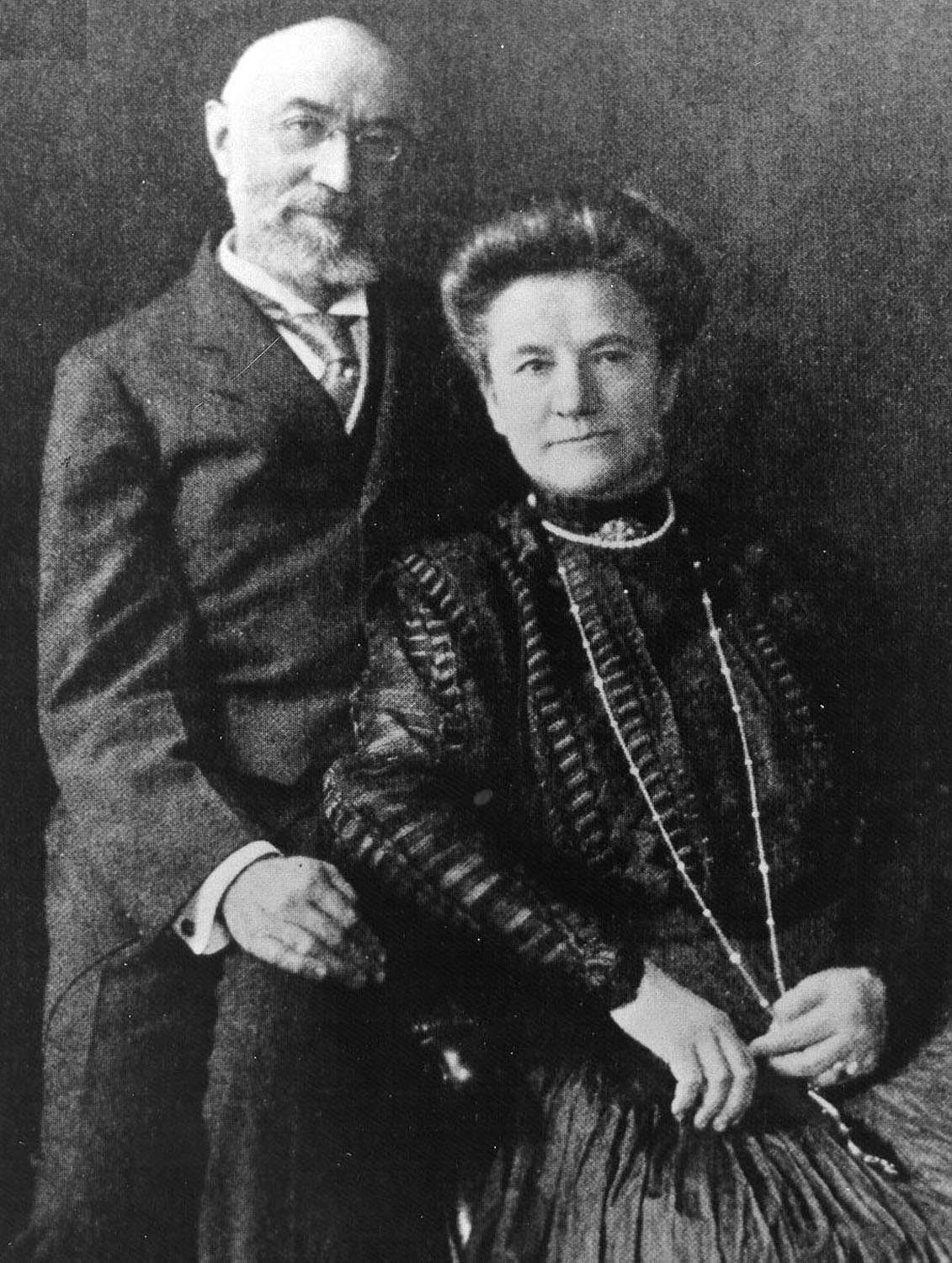
Isidor and Ida Straus, circa 1910. The couple were first-class passengers who died on the Titanic. (Wikimedia Commons)
Some descendants of the Titanic’s victims have expressed disapproval for the Titanic tourism industry that has emerged in recent years for wealthy adventurers like those on the Titan, AFP reports:
While for many the Titanic is a historical curiosity — as distant from today as the Parthenon or Pompeii — for descendants of those who perished there is something distasteful about ultra-wealthy tourists spending heavily to visit the wreck.
“I think it’s disgusting, quite honestly,” 69-year-old John Locascio, whose two uncles died in the tragedy, told The Daily Beast.
“They died a horribly tragic death. Just leave the bodies resting,” Locascio added. “They don’t want people down to see them. Just leave well enough alone.”
Update, 6:00 p.m. ET: The Coast Guard reports 6-7 ft. swells and winds up to 30 miles per hour in the search area.
Updated weather on scene: winds at 23mph with gusts up to 30mph. Sea state is 6-7ft swells with an air temp of 50°f. #Titanic
— USCGNortheast (@USCGNortheast) June 21, 2023
The Coast Guard also tweeted the latest maps of the search area:
As of now, these are the completed searches for the Titan, a 21-foot submersible from the Polar Prince, as of Wednesday afternoon.#Titanic pic.twitter.com/alpYBFA8kQ
— USCGNortheast (@USCGNortheast) June 21, 2023
Update, 12:00 p.m. ET: Breitbart’s Alana Mastrangelo reports that OceanGate Expeditions CEO Stockton Rush, who is aboard the missing Titan, explained in a recent interview that he preferred hiring a team that was “younger” and more “inspirational” rather than older and experienced:
“When I started the business, old-timers in the industry told me I was nuts, and they continue to tell me that — partly because I said I was going to take inexperienced pilots in a submarine, in current, in zero visibility — and they thought I was insane,” Rush told Teledyne Marine in a resurfaced Zoom interview.
The 61-year-old went on to say that “one of the things you’ll find, there are other sub operators out there, but they typically have gentlemen who are ex-military submariners, and you’ll see a whole bunch of 50-year-old white guys.”
“I wanted our team to be younger, to be inspirational, and I’m not going to inspire a 16-year-old to go pursue marine technology, but a 25-year-old who’s a sub pilot or a platform operator or one of our techs can be inspirational,” Rush said.
Read the rest here.
*****
Race Against the Clock
The submergible vessel called the Titan, operated by OceanGate Expeditions, has five people on board and only enough oxygen for up to 96 hours from the time it descends. The 21-foot craft began its descent in the North Atlantic on Sunday to visit the wreck site of the RMS Titanic, but it lost contact with the surface less than two hours later, according to authorities.
OceanGate Expeditions sells seats on the Titan at $250,000 apiece. The vessel was carrying three fee-paying passengers: British billionaire Hamish Harding, Pakistani tycoon Shahzada Dawood and his son Suleman. The other two on board have been identified as Paul-Henri “PH” Nargeolet, a veteran diver and expert on the Titanic wreck, and Stockton Rush, the CEO of OceanGate Expeditions.
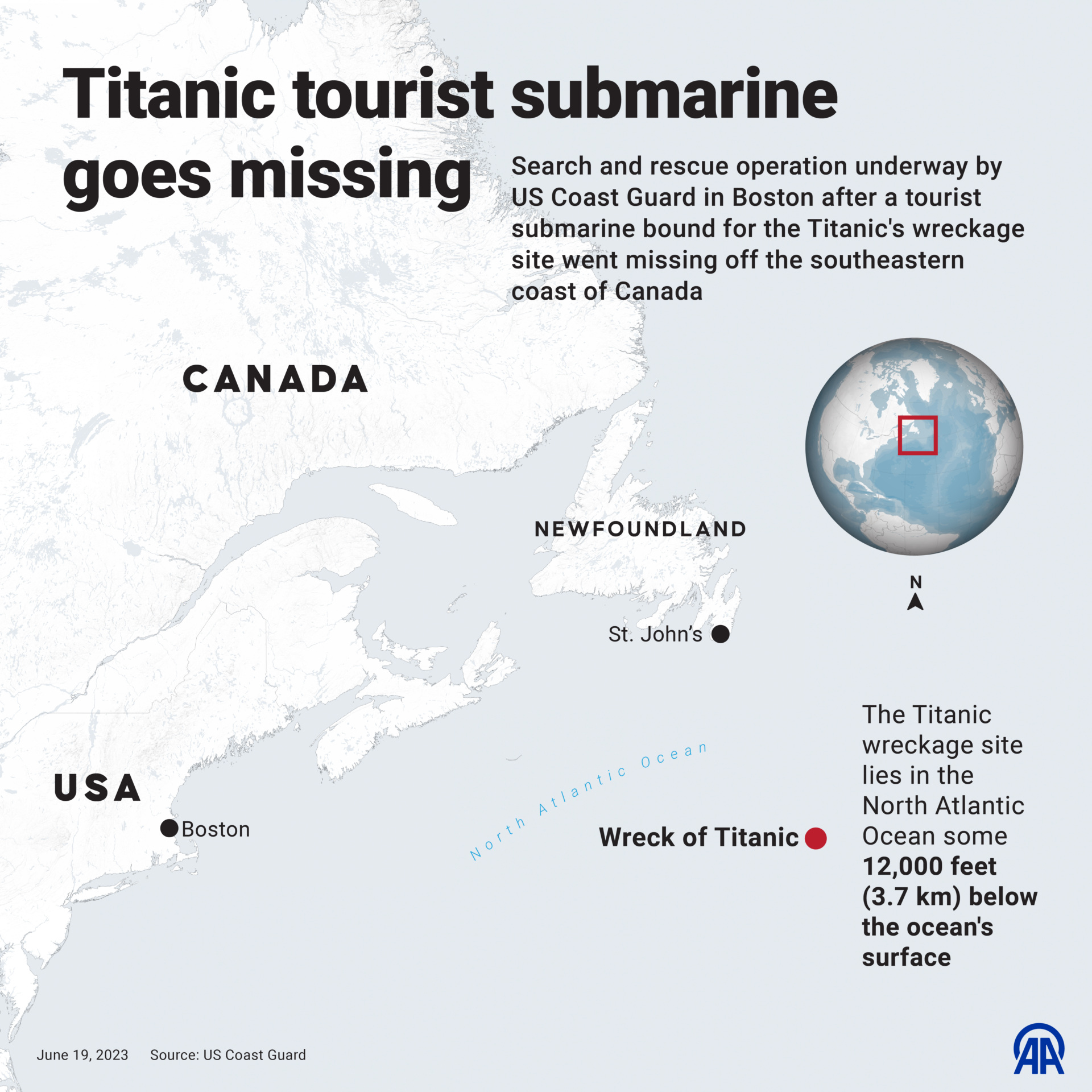
Map of the search and rescue operation underway by the U.S. Coast Guard for the Titan tourist sub. (Yasin Demirci/Anadolu Agency via Getty Images)
The U.S. and Canadian Coast Guards have deployed more ships and planes in an intensive search for the Titan, which was attempting to dive to the Titanic wreck site some 400 miles off the coast of Newfoundland, Canada, and 12,000-12,500 ft. below sea level.
The depth of such a dive makes rescue efforts especially difficult because very few vessels are able to travel to that depth. On top of that, the choppy waters of the North Atlantic are prone to heavy fog and storms, making even an aerial search of the surface challenging.
Coast Guard Captain Jamie Frederick told reporters on Wednesday that the rescue efforts are now covering an area over two-times the size of the state of Connecticut in waters two and a half miles deep.
“This is a search and rescue mission, 100 percent,” Frederick said, promising that “every available asset” would be used to find and save the Titan’s passengers.
WATCH FULL PRESS CONFERENCE:
The rescuers have deployed two camera-equipped remote-operated robots that can scan the seafloor in real-time at depths other vessels can’t reach. More of these robots are expected, officials said Wednesday.
All of these efforts are a race against time as the oxygen in the submersible runs out, the vessel fills with carbon dioxide, and the freezing water of the North Atlantic causes body temperatures to drop.
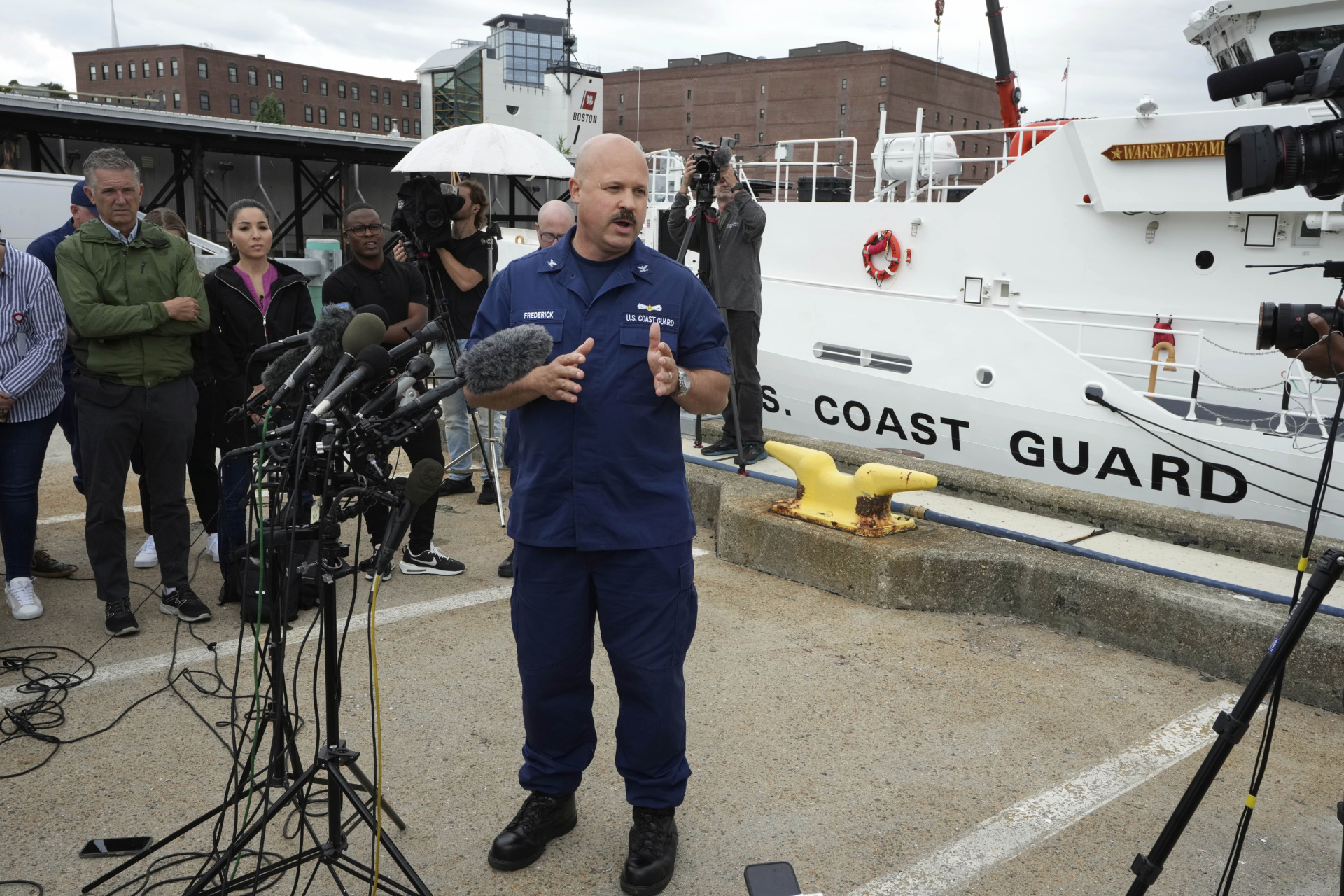
U.S. Coast Guard Capt. Jamie Frederick, center, faces reporters during a news conference, Tuesday, June 20, 2023, at Coast Guard Base Boston about the search for the missing submersible near the wreck of the Titanic. (AP Photo/Steven Senne)
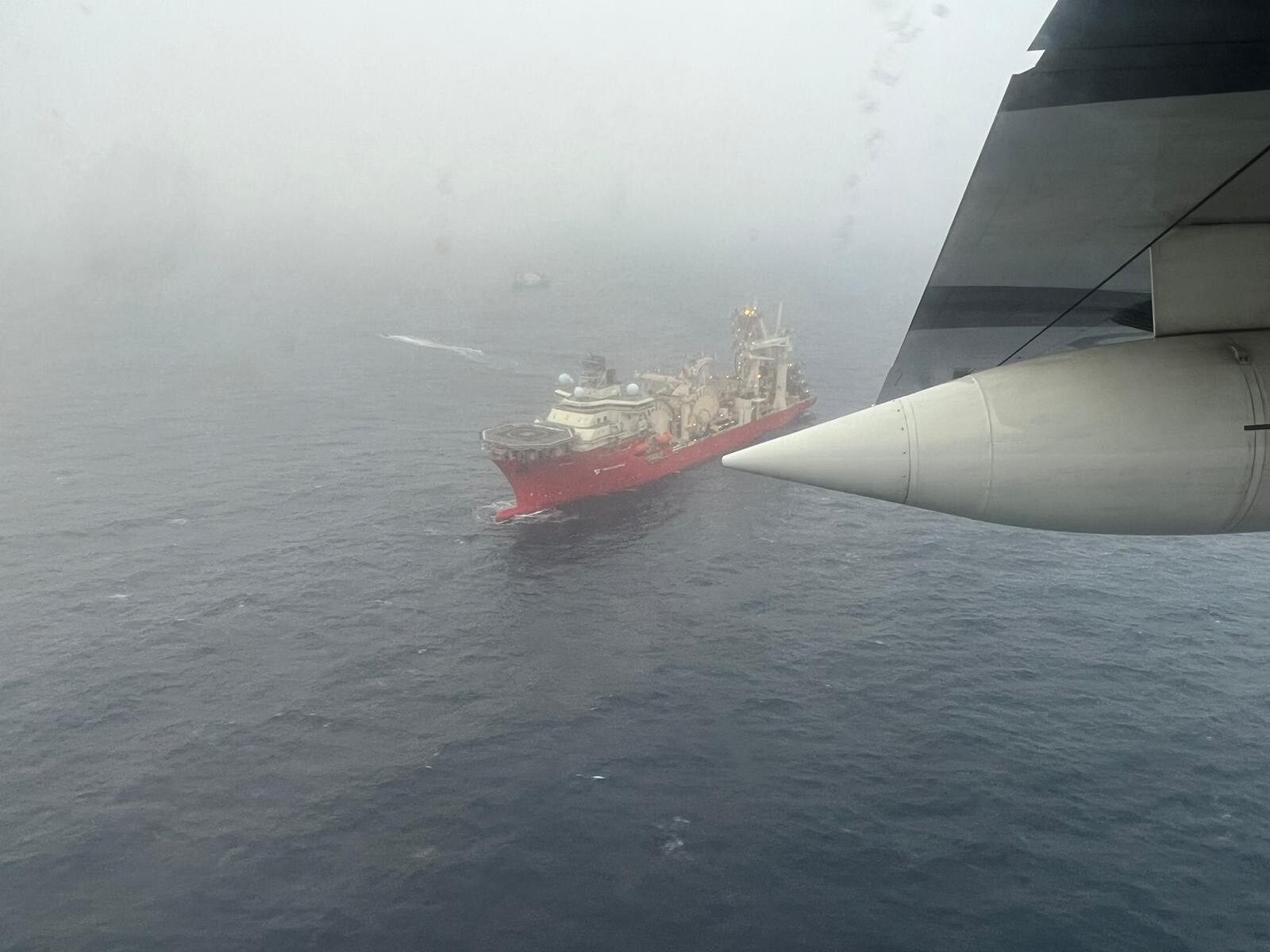
An aerial view of the Bahamian research vessel Deep Energy ship after it was arrived in the area for OceanGate Titan submersible search. (U.S. Coast Guard via Getty Images)
“Banging Noises”
On Wednesday, a Canadian military surveillance aircraft detected underwater noises. The Coast Guard wrote on Twitter that a Canadian P-3 Orion had “detected underwater noises in the search area.” Searchers then moved an underwater robot to that area to search. However, those searches “have yielded negative results but continue.”
Canadian P-3 aircraft detected underwater noises in the search area. As a result, ROV operations were relocated in an attempt to explore the origin of the noises. Those ROV searches have yielded negative results but continue. 1/2
— USCGNortheast (@USCGNortheast) June 21, 2023
Additionally, the data from the P-3 aircraft has been shared with our U.S. Navy experts for further analysis which will be considered in future search plans. 2/2 #Titanic
— USCGNortheast (@USCGNortheast) June 21, 2023
In underwater disasters, a crew unable to communicate with the surface relies on banging on their submersible’s hull to be detected by sonar.
In his press conference on Wednesday, Coast Guard Captain Frederick said they are monitoring the noises, but they have still not determined the exact location of the sounds or if they are coming from the missing vessel.
“We don’t know what they are, to be frank,” he said, but added that the noises may help the rescue teams narrow their search.
Retired Navy Capt. Carl Hartsfield, now the director of the Woods Hole Oceanographic Systems Laboratory, told a news conference Wednesday that the sounds have been described as “banging noises,” but warned that search crews “have to put the whole picture together in context and they have to eliminate potential manmade sources other than the Titan.”
WATCH: France Sends Ship with Deep-Sea Robot to Help Search for Missing Titanic Tourist Sub
Ifremer via StoryfulThree C-17 transport planes from the U.S. military have been used to move commercial submersible and support equipment from Buffalo, New York, to St. John’s, Newfoundland, to aid in the search, a spokesperson for U.S. Air Mobility Command said. The Canadian military said it provided a patrol aircraft and two surface ships, including one that specializes in dive medicine. It also dropped sonar buoys to listen for any sounds from the Titan.
In addition to an international array of ships and planes, an underwater robot had started searching in the vicinity of the Titanic and there was a push to get salvage equipment to the scene in case the sub is found.

Rescue teams try to trace the origin of sounds heard from the depths of the North Atlantic in a search for a tourist submersible Titan at the U.S. Coast Guard base in Boston, Massachusetts, on June 21, 2023 (Fatih Aktas/Anadolu Agency via Getty Images)

A U.S. Coast Guard vessel sits in port in Boston Harbor across from the U.S. Coast Guard Station Boston on June 19, 2023. (Joseph Prezioso/AFP via Getty Images)
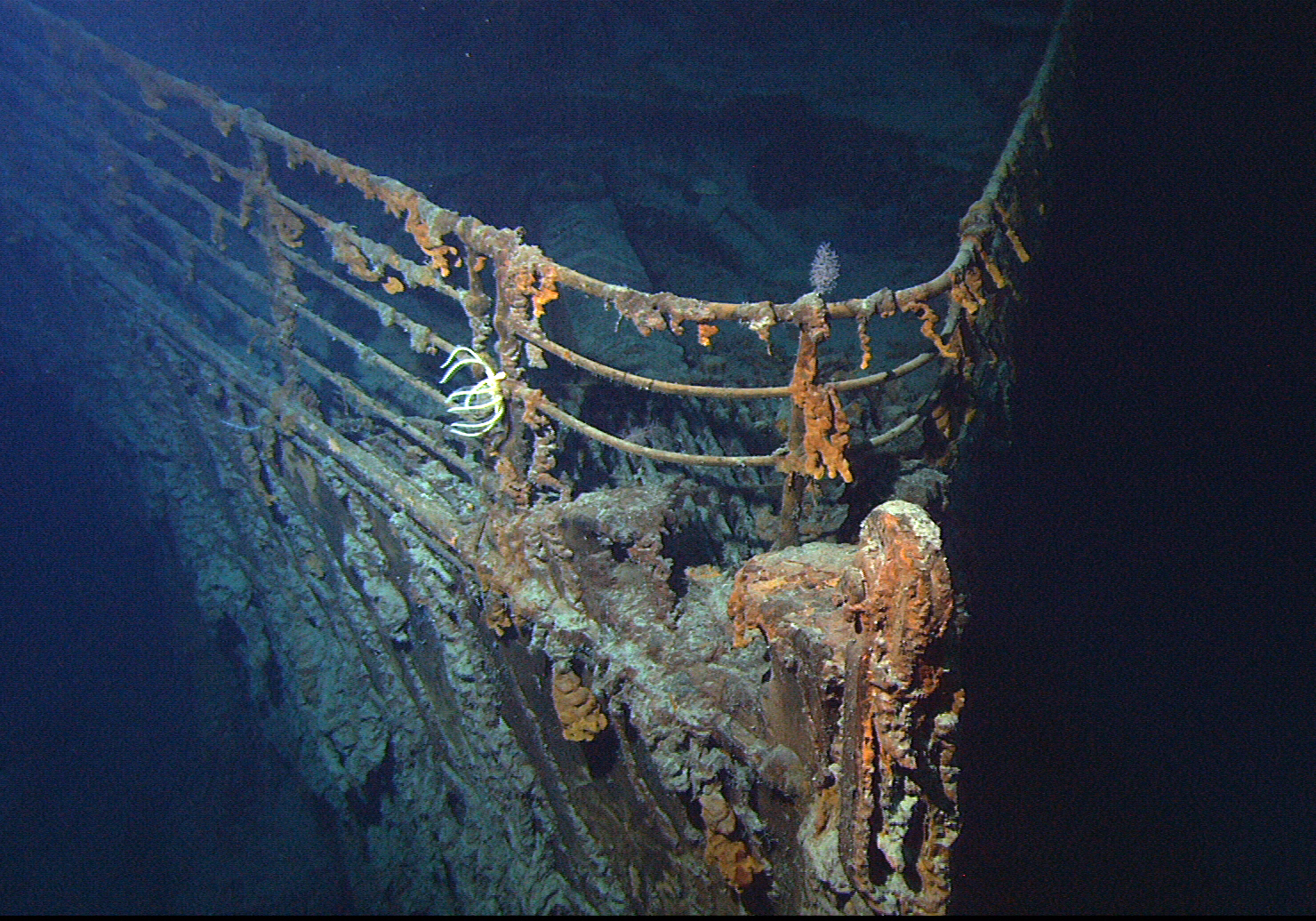
View of the bow of the RMS Titanic photographed in June 2004 by the ROV Hercules during an expedition returning to the shipwreck of the Titanic. (Courtesy of NOAA/Institute for Exploration/University of Rhode Island)
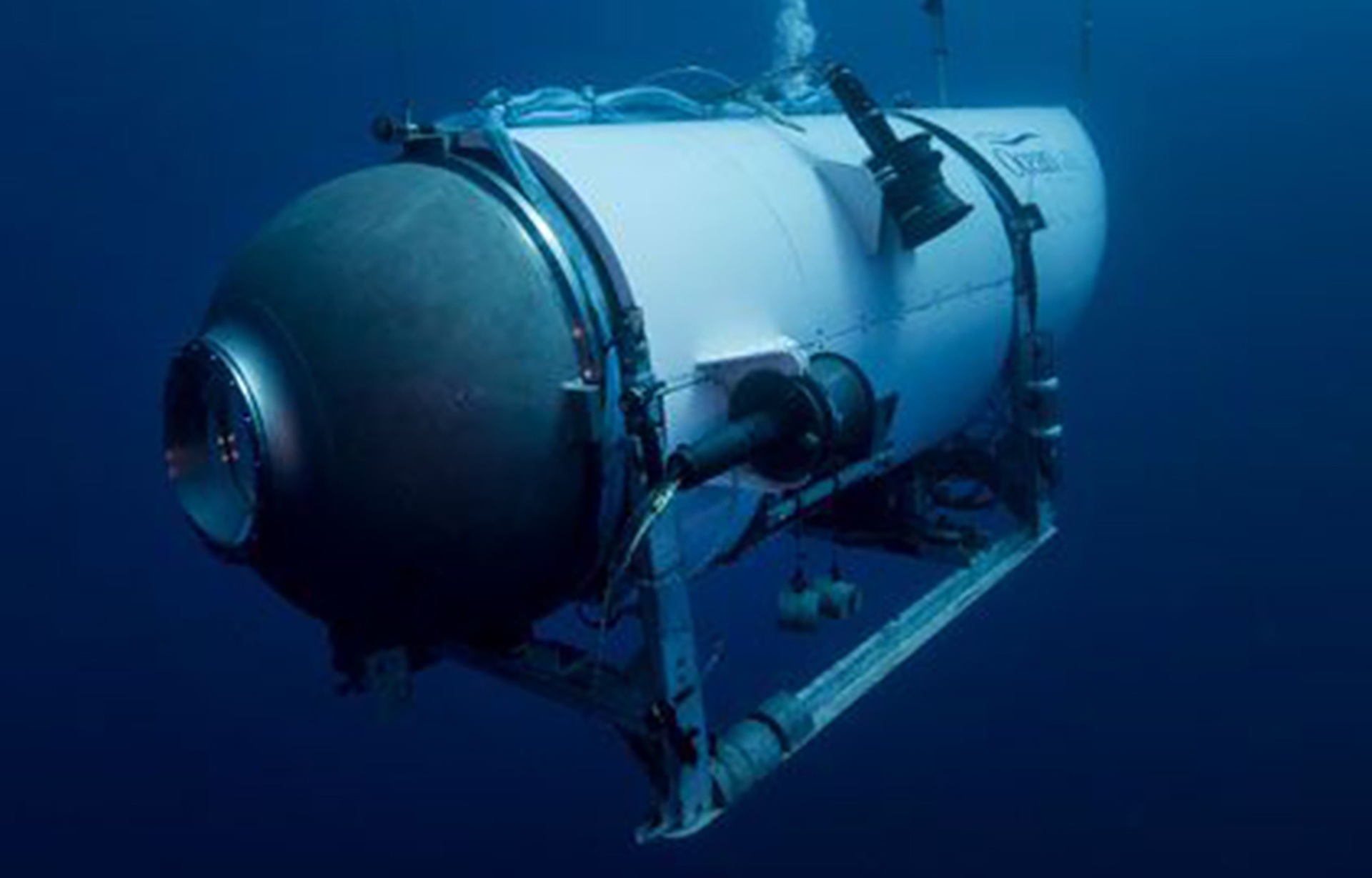
This undated photo provided by OceanGate Expeditions in June 2021 shows the company’s Titan submersible. (OceanGate Expeditions via AP)
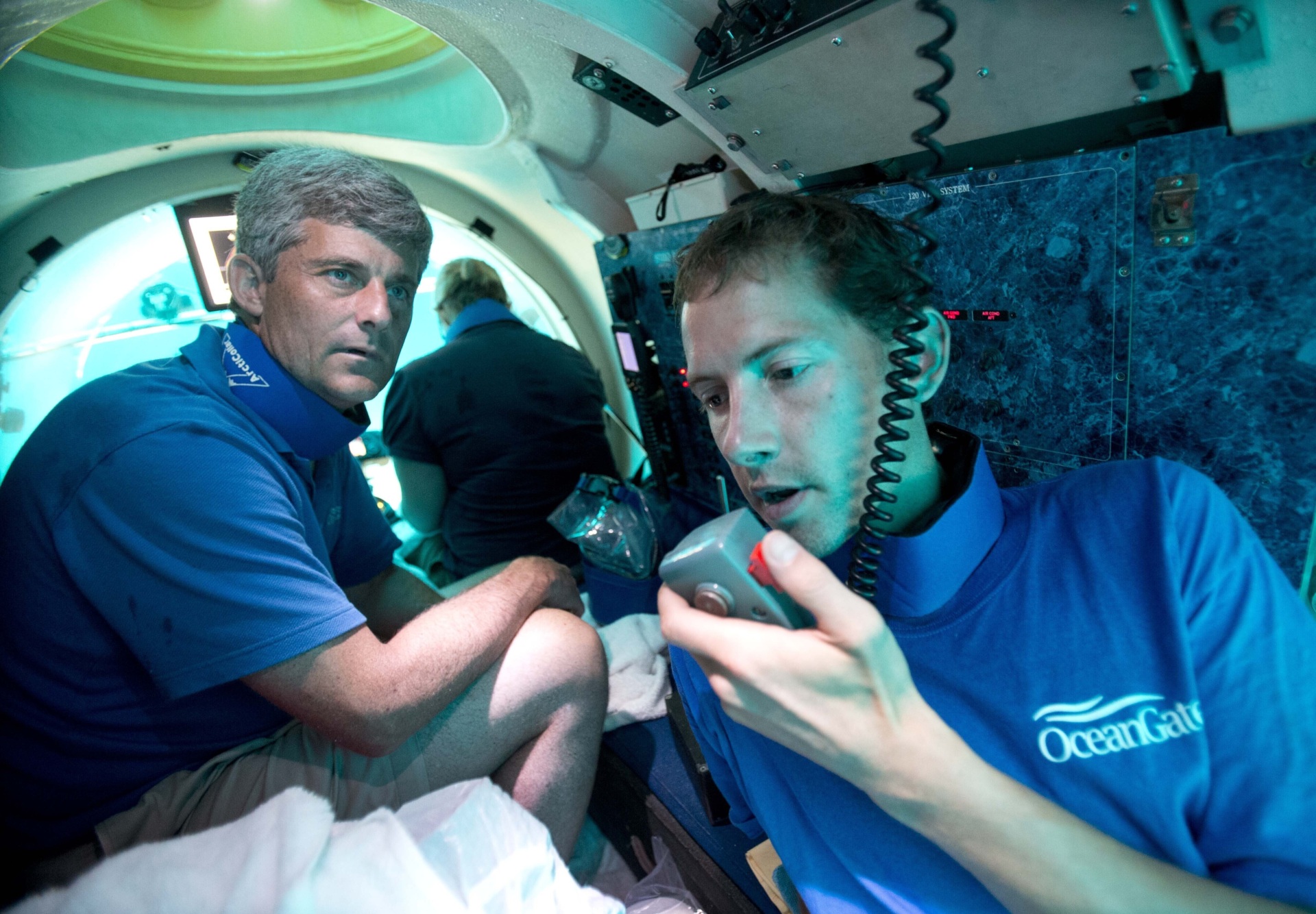
Submersible pilot Randy Holt, right, communicates with the support boat as he and Stockton Rush, left, CEO and Co-Founder of OceanGate, dive in the company’s submersible, “Antipodes,” about three miles off the coast of Fort Lauderdale, Florida, on June 28, 2013. (AP Photo/Wilfredo Lee, File)
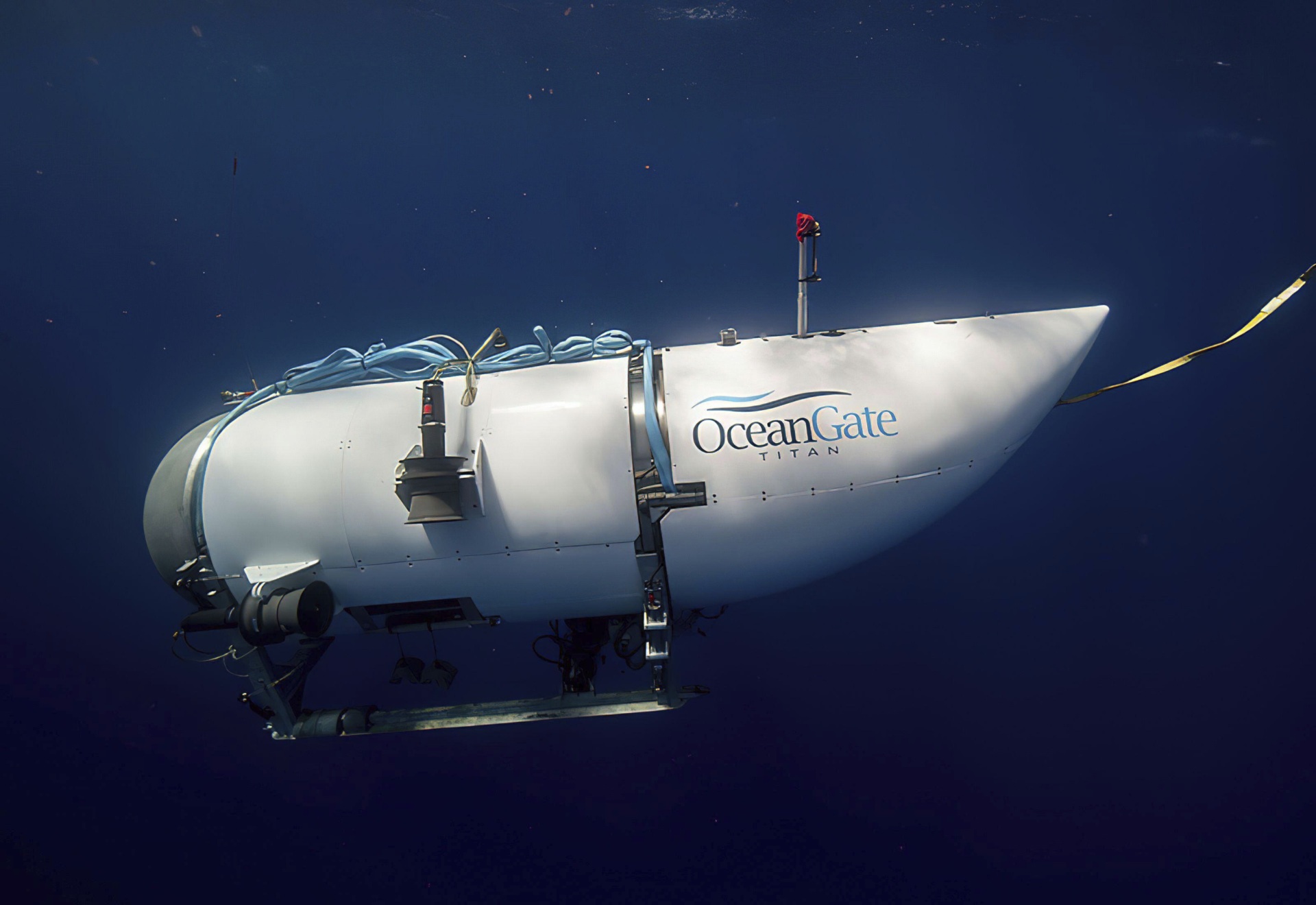
This photo provided by OceanGate Expeditions shows a submersible vessel named Titan used to visit the wreckage site of the Titanic. (OceanGate Expeditions via AP)
Rescuers have been racing against the clock because even under the best of circumstances the vessel could run out of oxygen by Thursday morning. The submersible had a four-day oxygen supply when it put to sea around 6 a.m. Sunday, according to David Concannon, an adviser to OceanGate Expeditions, which oversaw the mission.
Spotlight on OceanGate Expeditions’ Safety Problems
OceanGate Expeditions is also under increased scrutiny as documents show that the company had been warned there might be catastrophic safety problems posed by the way the experimental vessel was developed.
David Lochridge, OceanGate’s director of marine operations, said in a 2018 lawsuit that the company’s testing and certification was insufficient and would “subject passengers to potential extreme danger in an experimental submersible.”
Breitbart’s Lucas Nolan reports:
David Lochridge, the Titan project’s director of marine operations, was let go in 2018 after calling for more stringent safety inspections of the submersible, including “testing to prove its integrity.” Lochridge was quoted as having “disagreed with OceanGate’s position to dive the submersible without any non-destructive testing to prove its integrity, and to subject passengers to potential extreme danger in an experimental submersible.”
In 2018, Lochridge published a report that was critical of the company’s research and development efforts for the vessel, according to legal filings. He had “strongly encouraged that OceanGate utilize a classification agency, such as the American Bureau of Shipping, to inspect and certify the Titan.” OceanGate, however, turned down both requests.
Despite the concerns expressed by Lochridge, OceanGate declined to have the submersible independently inspected, a practice known as “classing” that is common in the industry. This procedure entails appointing a neutral group to guarantee that submersibles and other vessels adhere to high technical standards set by the entire industry. It is thought to be essential for making sure a vessel is fit for operation.
Classification could take years, according to OceanGate, who defended their choice by saying that it would be “anathema to rapid innovation.” The company stated, “While classing agencies are willing to pursue the certification of new and innovative designs and ideas, they often have a multi-year approval cycle due to a lack of pre-existing standards… Bringing an outside entity up to speed on every innovation before it is put into real-world testing is anathema to rapid innovation.”
It has since come to light that the vessel didn’t even appear to have a basic safety beacon installed.
For its part, OceanGate insisted that Lochridge was “not an engineer and was not hired or asked to perform engineering services on the Titan.” The firm also says the vessel under development was a prototype, not the now-missing Titan.
The Marine Technology Society, which describes itself as “a professional group of ocean engineers, technologists, policy-makers, and educators,” also expressed concern that year in a letter to OceanGate CEO Stockton Rush. The society said it was critical that the company submit its prototype to tests overseen by an expert third party before launching in order to safeguard passengers.
Why Visit the Titanic?
The doomed luxury liner RMS Titanic has long been a source of fascination as the quintessential morality tale of the Gilded Age.
The White Star Line’s RMS Titanic set sail on its maiden voyage from England to New York in April 1912 with 2,224 passengers and crew on board, including some of the most famous tycoons and aristocrats of the day.
But disaster struck on the night of April 15, when the ship hit an iceberg and sank. About 1,500 passengers and crew lost their lives in the freezing waters of the North Atlantic. The lucky ones who escaped in lifeboats—of which there were not enough for every passenger—were rescued the next morning by the RMS Carpathia.
The sinking of the Titanic remains the most famous maritime disaster in history and the fourth most deadly of the twentieth century.
The disaster became popularized as an example of hubris because the ship had been touted as an “unsinkable” miracle of the industrial age.
Some also see it as an example of the Gilded Age’s class discrimination because the vast majority of the passengers who died were in second and third class. In fact, more first class male passengers survived than third class children, despite the crew’s instructions for women and children to be given priority in the limited number of lifeboats.
The official inquests and congressional hearings in Great Britain and the United States following the disaster led to important maritime reforms, including new laws requiring sufficient lifeboats and other safety features for ocean liners.
The wreck of the Titanic was located in 1985 by a U.S.-French expedition, which again sparked the public’s interest in the story of the legendary ship. This in turn inspired director James Cameron’s Oscar-winning 1997 movie Titanic and also galvanized a lucrative underwater tourism industry near the wreckage.
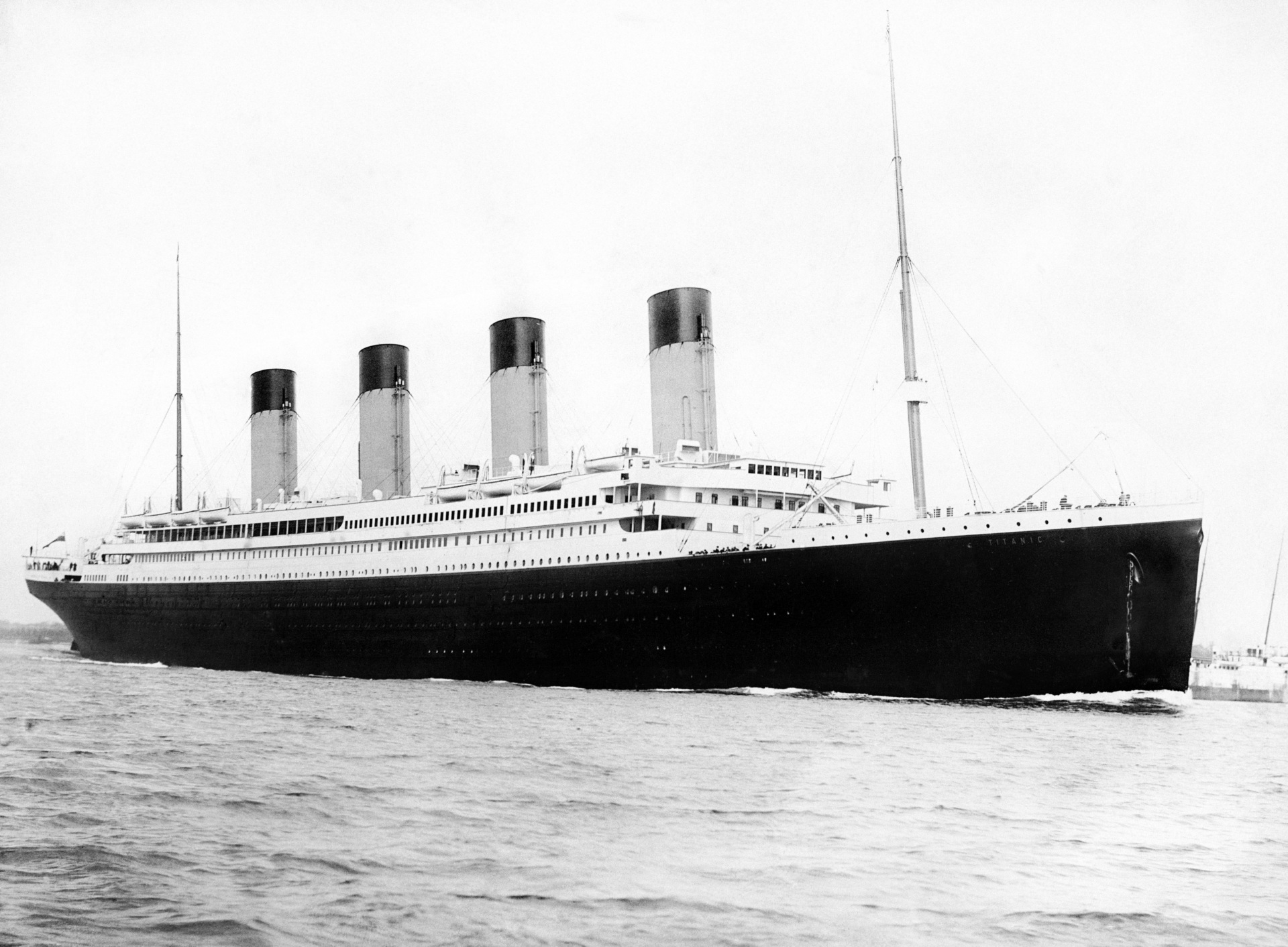
RMS Titanic is seen departing Southampton, England, on 10 April 1912. (Pictures from History/Universal Images Group via Getty Images)

The Aft First Class staircase leading to the a la carte restaurant on the RMS Titanic, the world’s most luxurious ocean liner at the time of its launching in April of 1912. (Ralph White/CORBIS/Corbis via Getty Images)

The First Class Lounge on board RMS Titanic, photographed on 4th January 1912. (Universal Images Group/Getty Images)

Illustration depicting women and children being loaded into life boats during the Titanic’s sinking on April 14, 1912. (Getty Images)
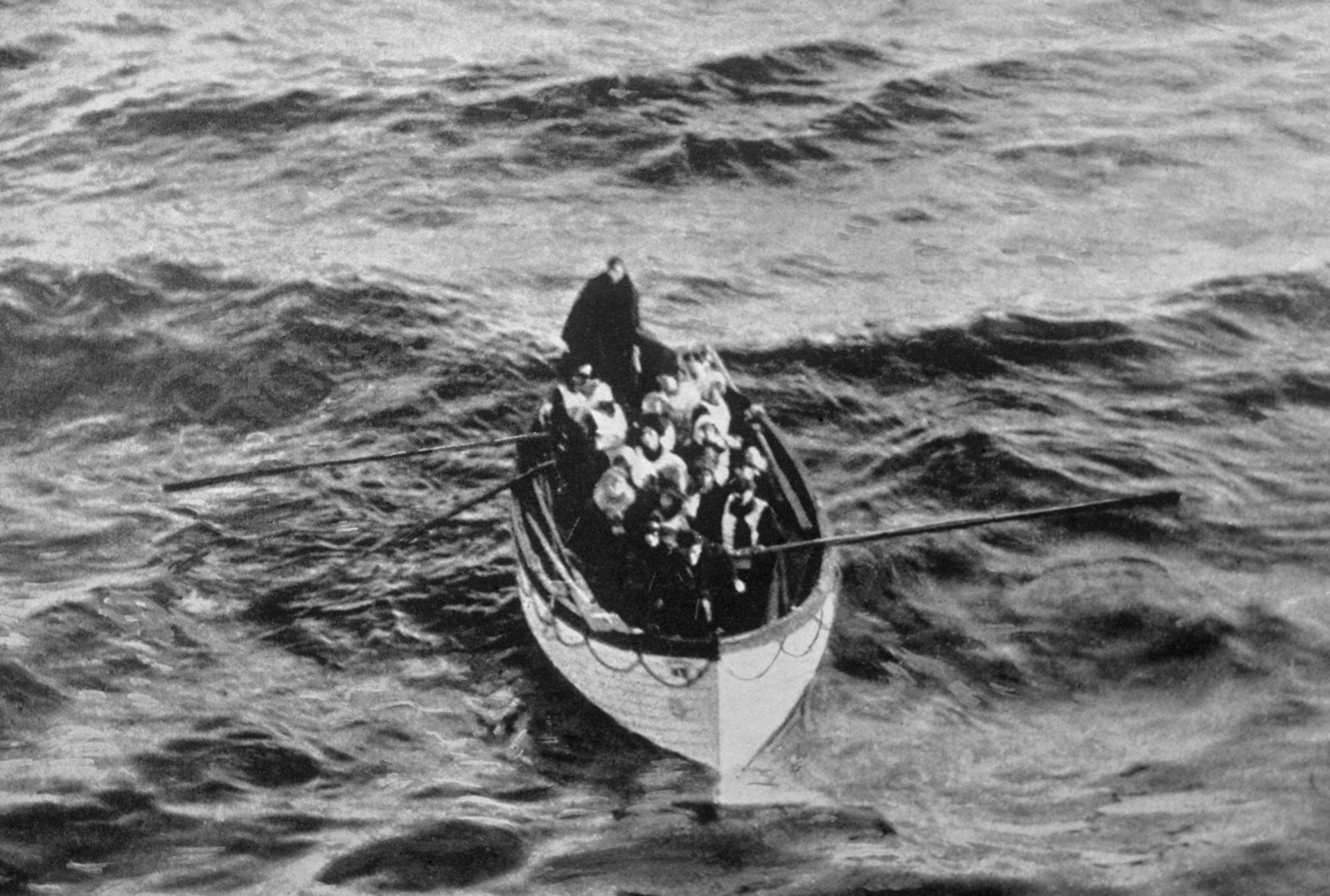
A lifeboat carrying a few survivors from the Titanic, seen floating near the rescue ship Carpathia on the morning of April 15, 1912, hours after the disaster. Titanic did not carry enough lifeboats to save all her passengers, and many of the available boats were launched carrying fewer than their 65-passenger capacity. (Ralph White/CORBIS/Corbis via Getty Images)

Titanic survivors are seen on lifeboats making their way to the Carpathia. (Universal History Archive/Getty Images)

Crowds gather around the bulletin board of the New York American, in New York City, where the names of people rescued from the sinking Titanic are on display. (AP Photo)
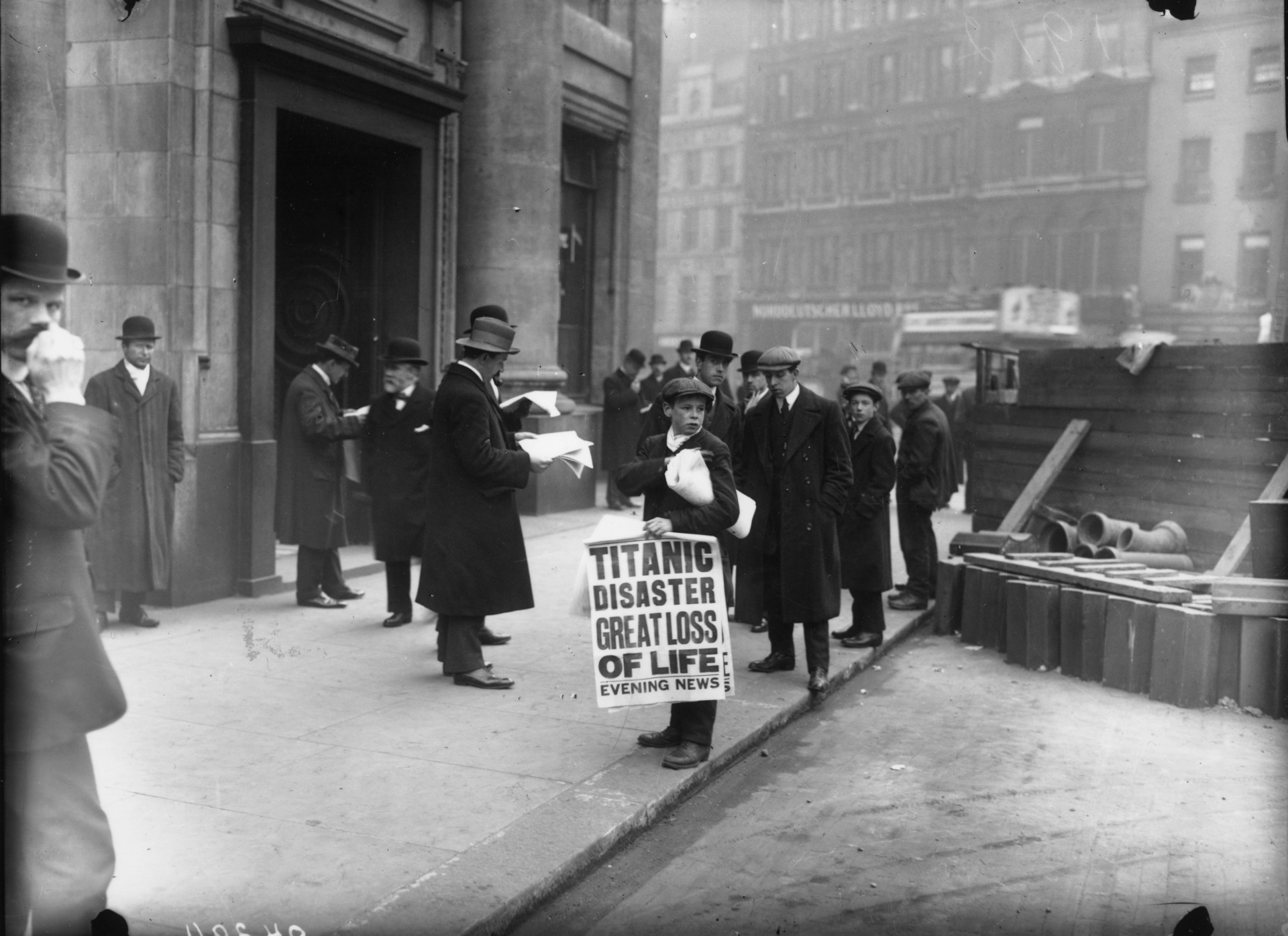
Newspaper boy Ned Parfett sells copies of the Evening News telling of the Titanic maritime disaster, outside Oceanic House, the London offices of the Titanic’s owner, the White Star Line, in Cockspur Street, London, 16 April 1912. (Topical Press Agency/Hulton Archive/Getty Images)
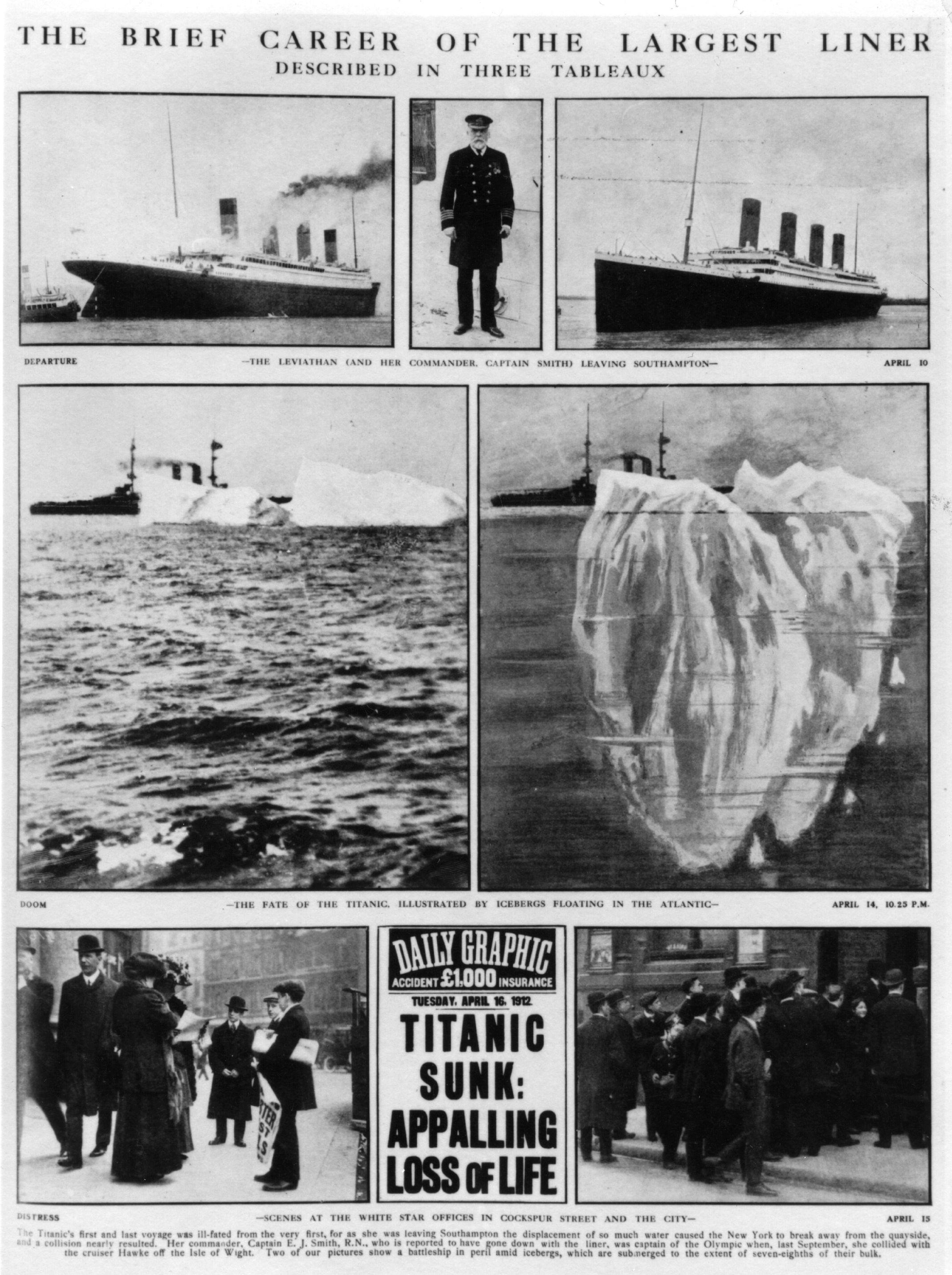
A newspaper’s montage of the brief career of the Titanic in photographs and illustrations. (Hulton Archive/Getty Images)

Photograph of the coffins of some of the victims of the sinking of the RMS Titanic at a mass burial. (Universal History Archive/Universal Images Group via Getty Images)
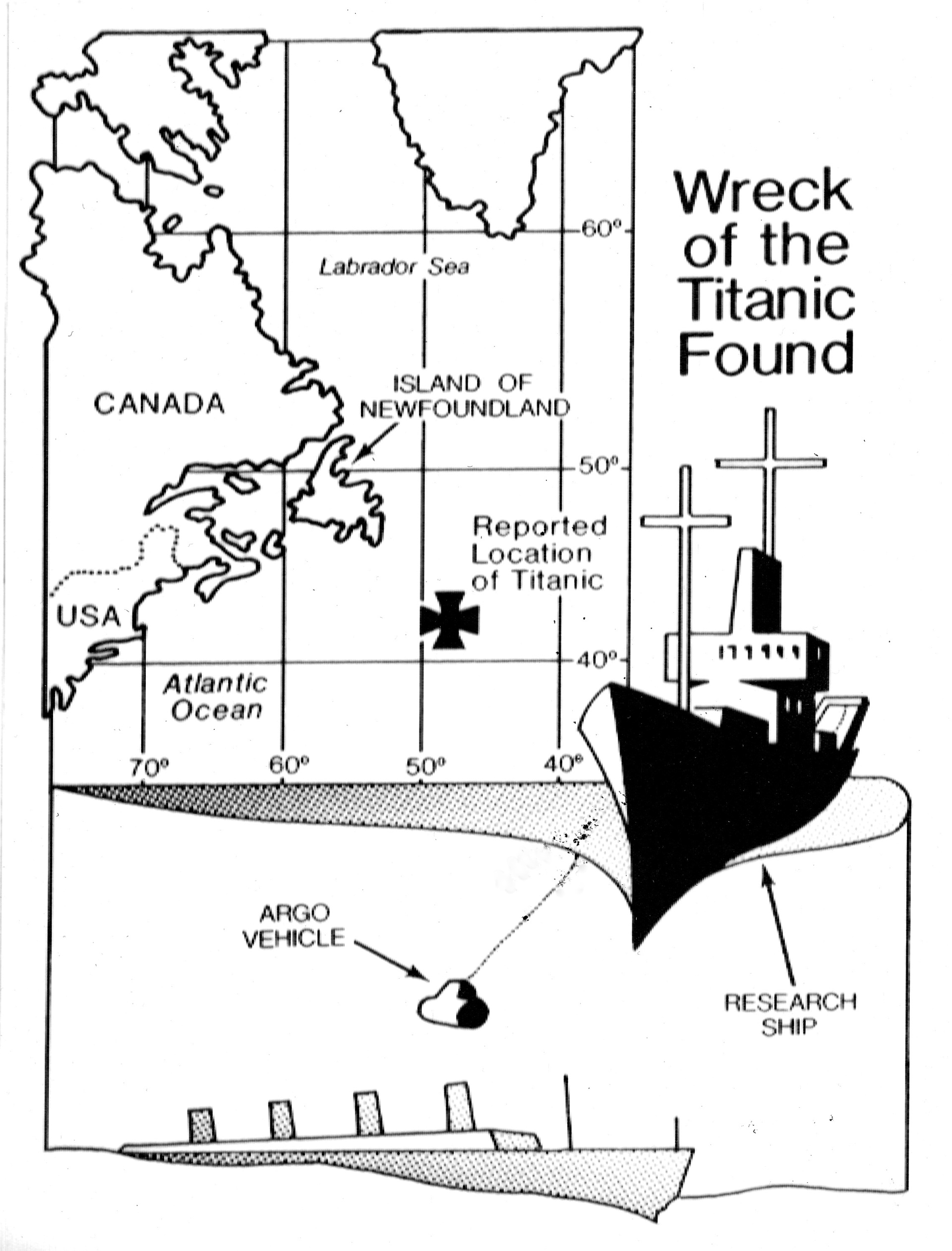
A graphic illustrates the location where the wreck of the Titanic was found upright and intact by scientists on September 1, 1985. It lies 560 miles (900 km) west of Newfoundland in water two and a half miles (4000 meters) deep. (AP Photo)

View of the bow of the RMS Titanic photographed in June 2004 by the ROV Hercules during an expedition returning to the shipwreck of the Titanic. (Courtesy of NOAA/Institute for Exploration/University of Rhode Island)
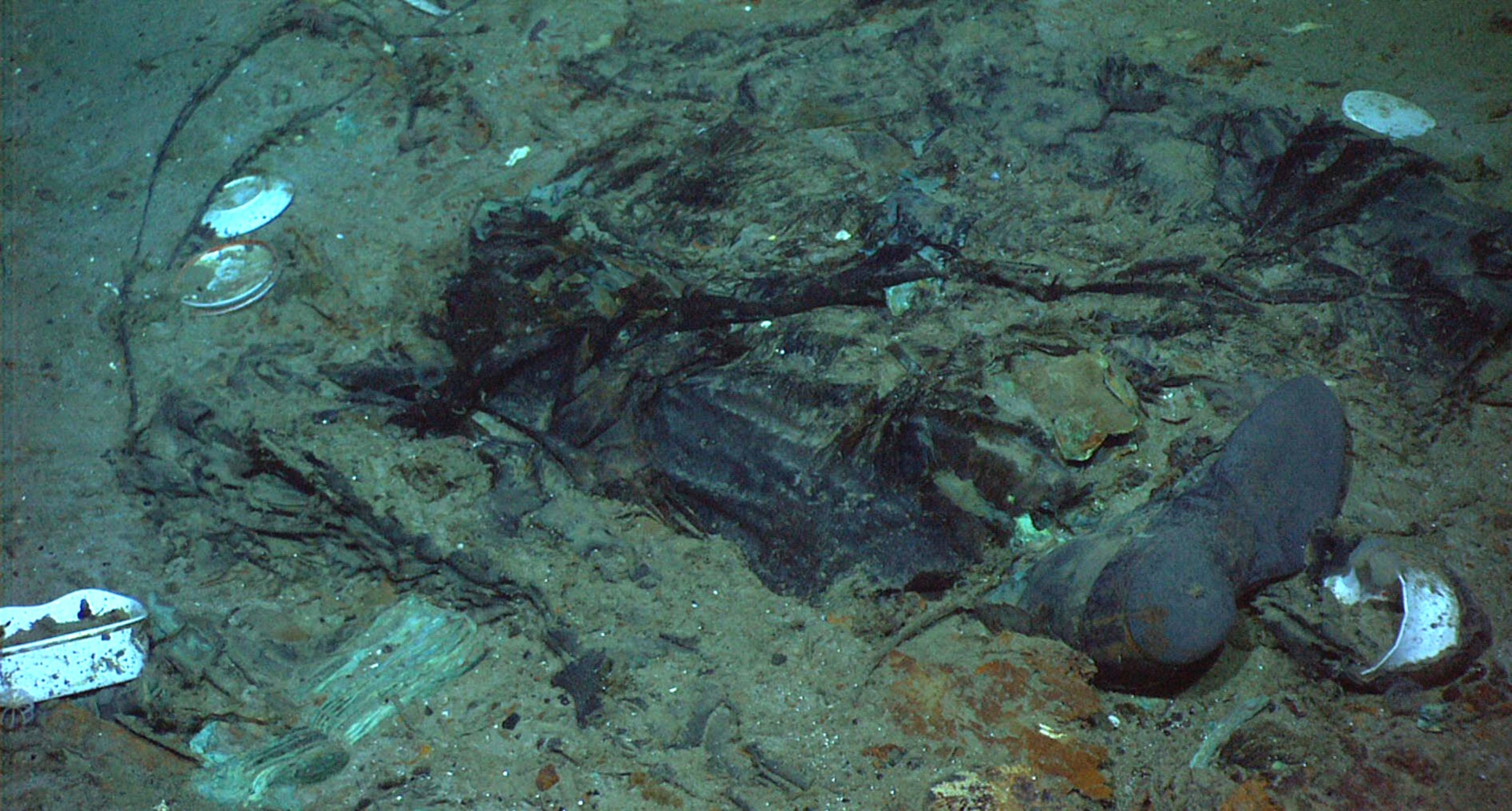
This 2004 photo shows the remains of a coat and boots in the mud on the sea bed near the Titanic’s stern. (Institute for Exploration, Center for Archaeological Oceanography/University of Rhode Island/NOAA Office of Ocean Exploration)
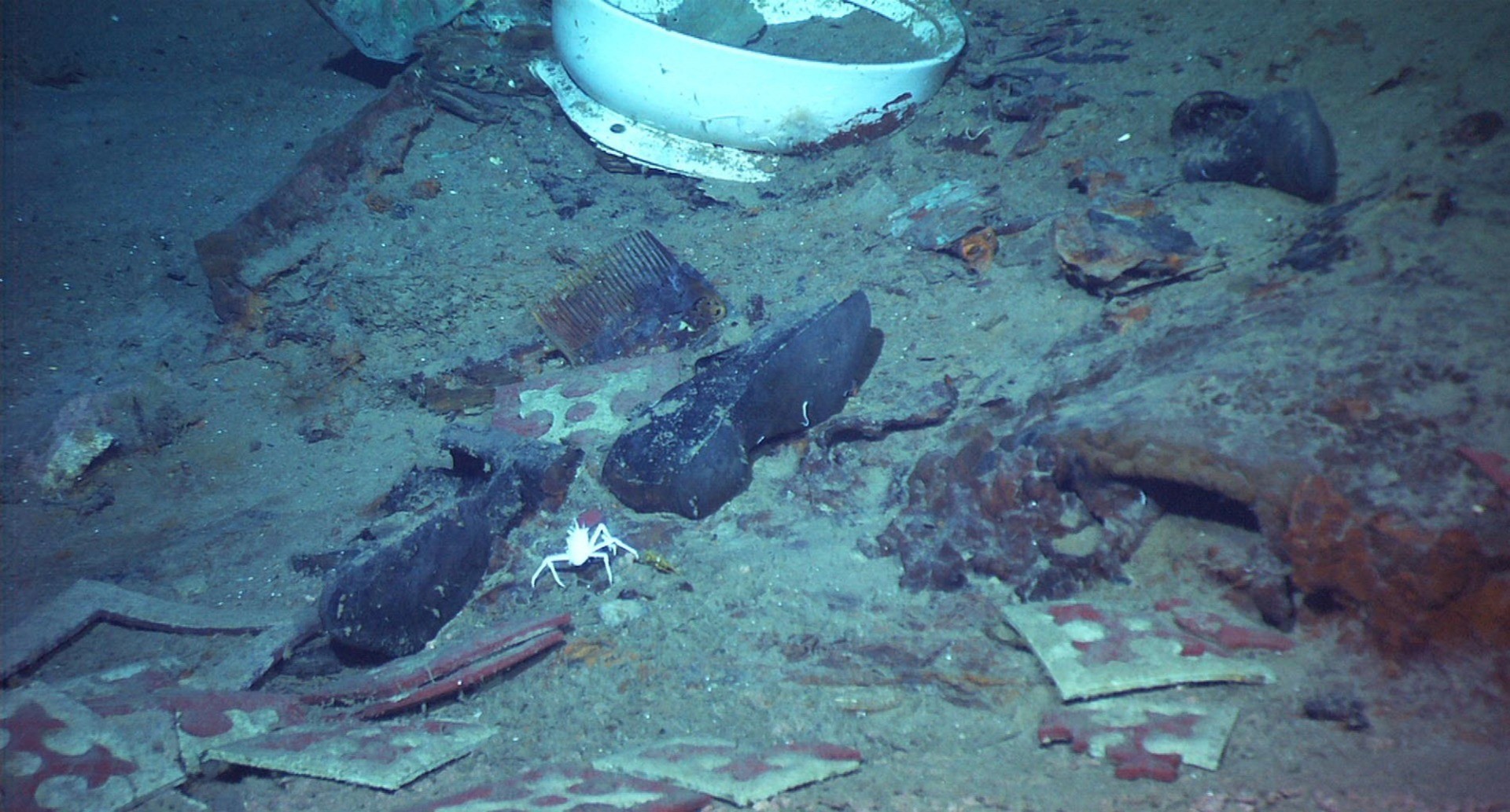
This 2004 image shows the shoes of one of the possible victims of the Titanic disaster. (Institute for Exploration and Center for Archaeological Oceanography/University of Rhode Island/NOAA Office of Ocean Exploration via AP)
This is a developing story.
The Associated Press and AFP contributed to this story.
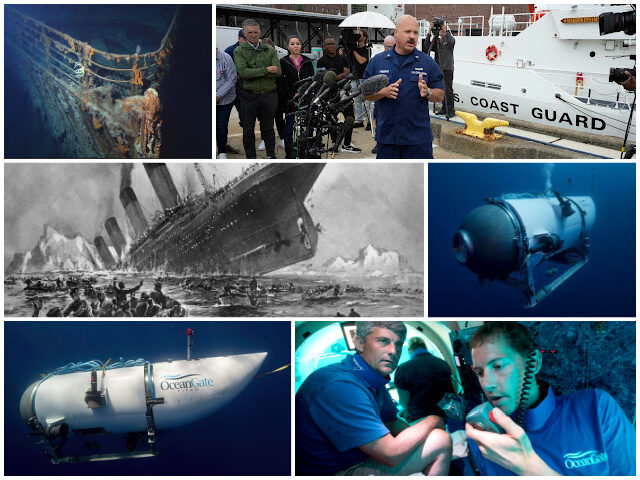
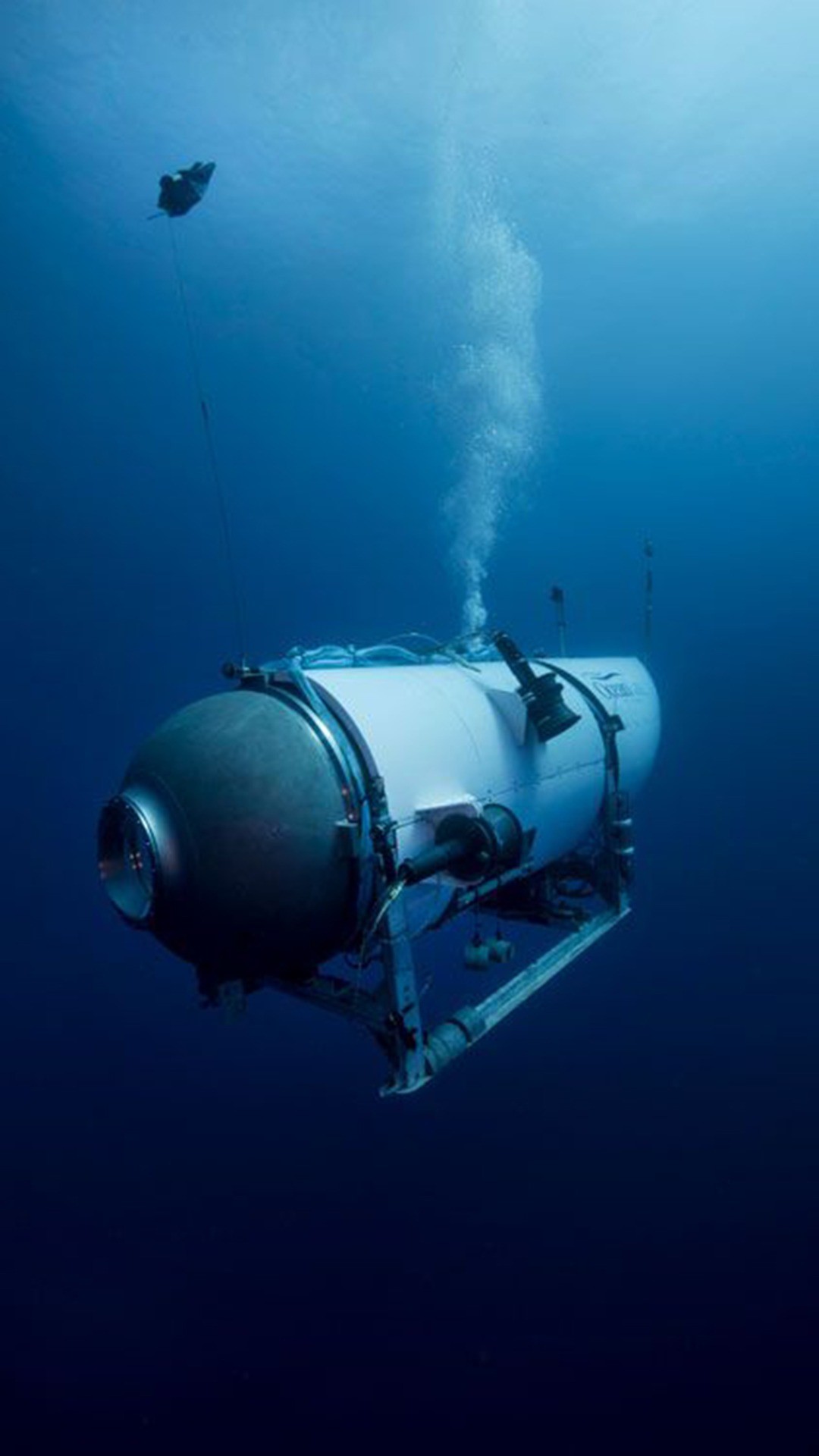

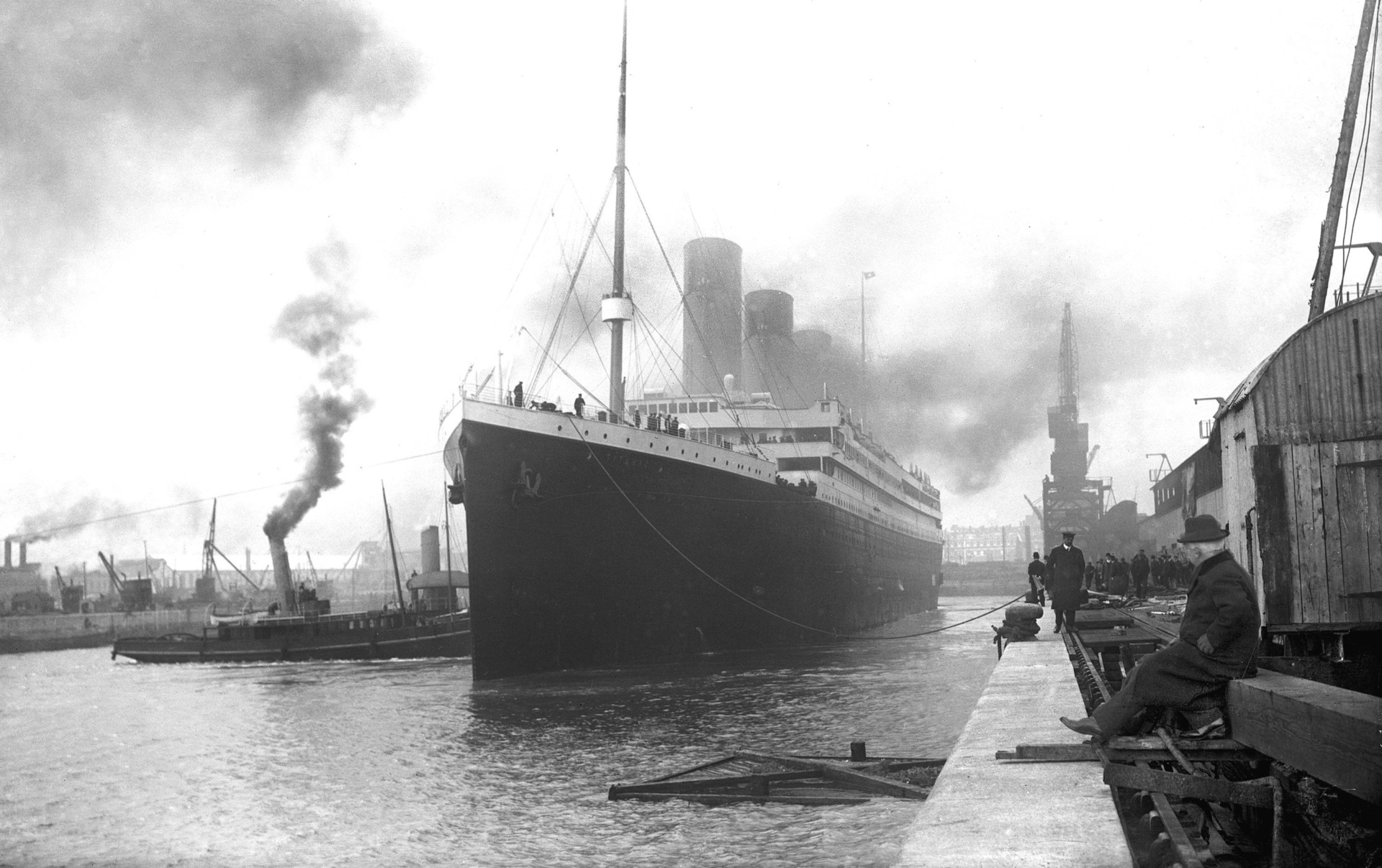
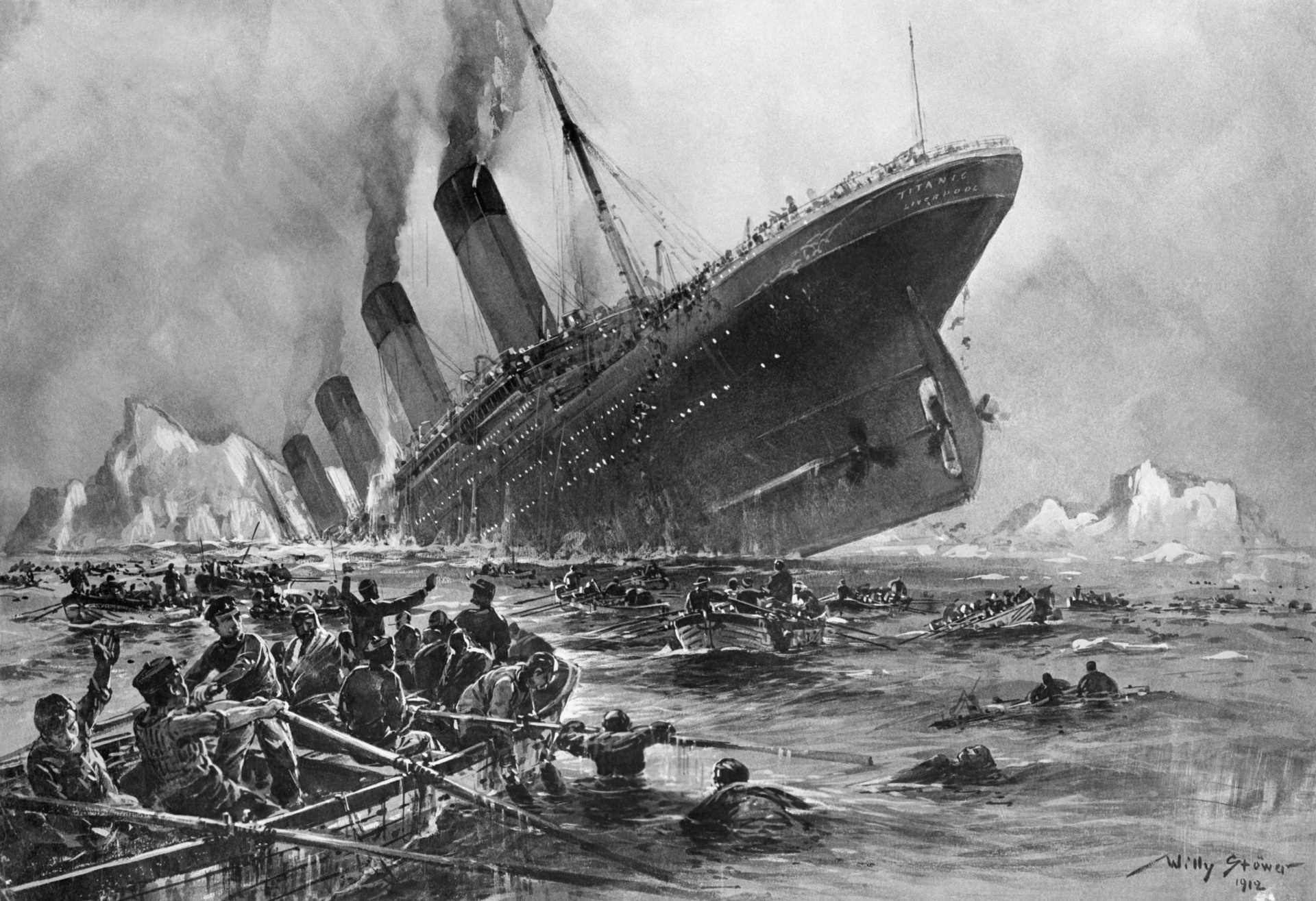
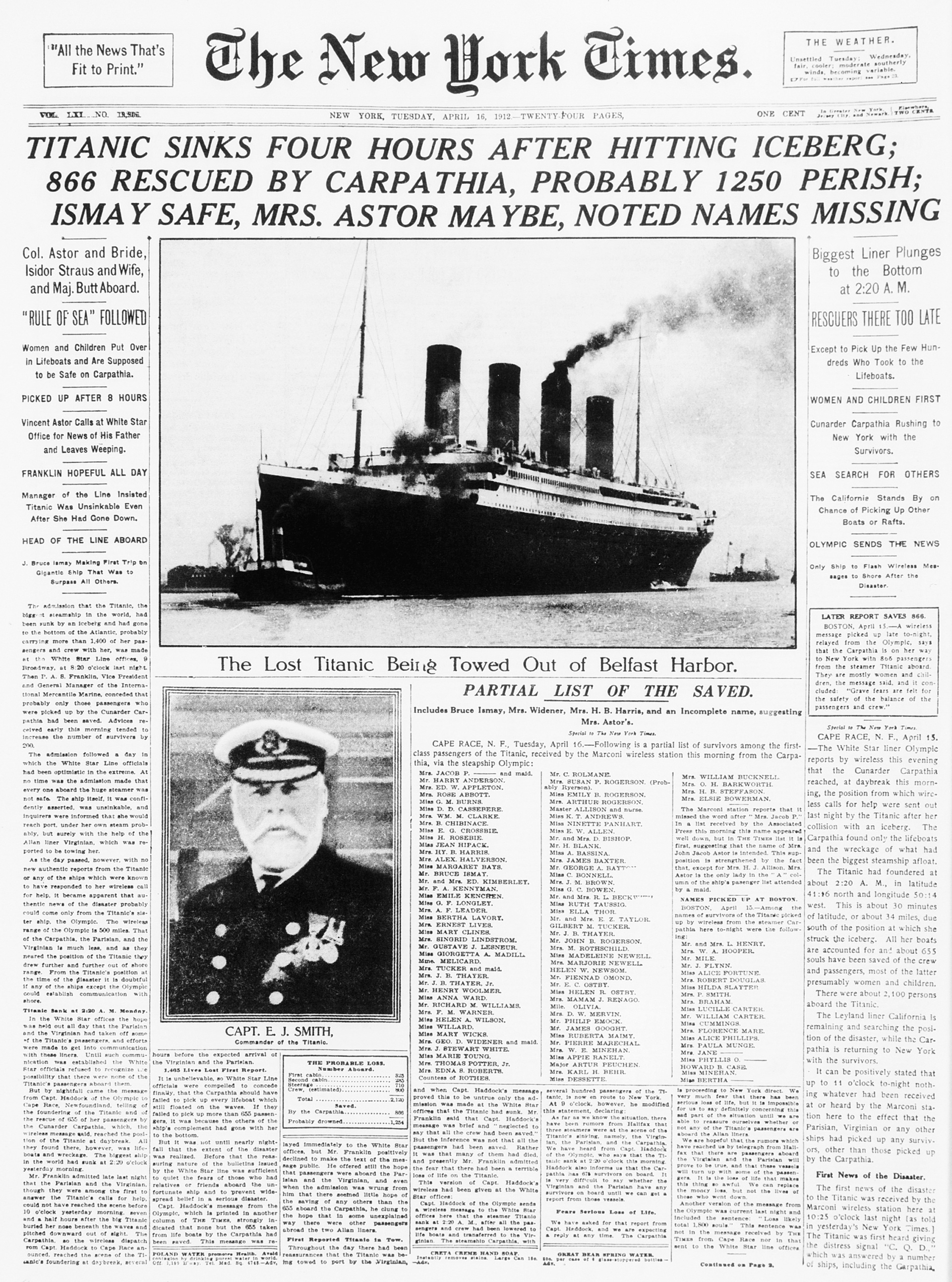
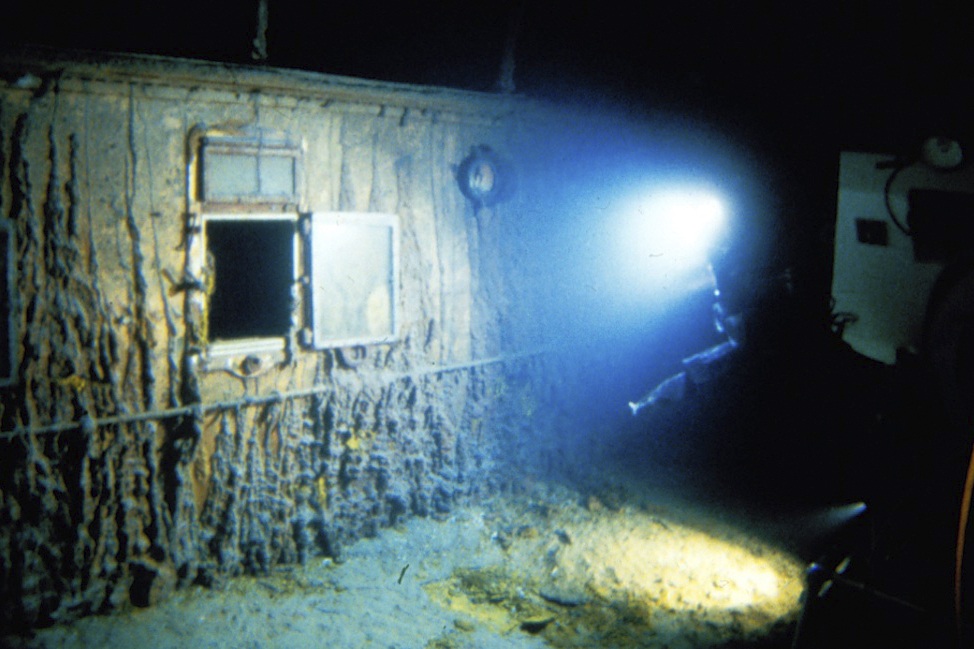
COMMENTS
Please let us know if you're having issues with commenting.